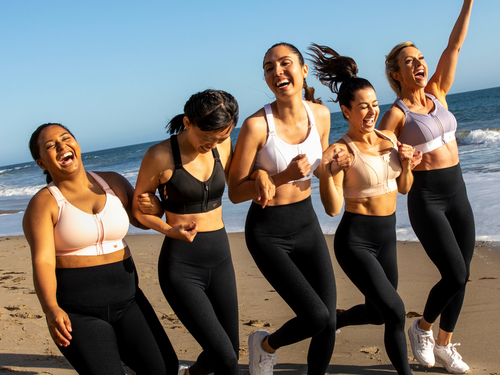Order by 12/9 for delivery by Christmas
What Are Bra Sister Sizes And Why Do They Matter?
Your old standby bra doesn’t fit anymore, which is so aggravating. Maybe it’s because the elastic is too worn, or perhaps you genuinely need a new bra size. That's where bra sister sizes come to the rescue - here's how:
Bra sister sizes share a similar cup volume but a different band and cup letter size. A bra sister size maintains cup capacity while adjusting the tightness of the band, leading to a better fit in some instances. For example, if a bra is a 30B, its direct sister size up is 32A, while down is 28C.
Are you still a little confused? Don’t stress, as we’ll unpack everything ahead and demystify sister sizes once and for all. You’ll learn which bras are sister sizes and how to measure for your sister size, so keep reading.
Bra Sister Size Chart and How to Read It
Sure, bra sister sizes look overwhelming at first glance, but they shouldn't be so complicated now that you understand the 3 most important components behind them. Here's how you read a bra sister size chart:
- Band Sizes: Each band size number is confined to a column, increasing left to right
- Cup Letters: Each cup letter increases as you go down the table, but decreases as you read it left to right.
If you want to simplify the whole exercise, just type your bra size into the interactive image at the top of this section. If you want to find out ways to simplify the process as well as how to calculate yours without the calculator above, keep reading.
3 Thoughts to Simplify Sister Sizes
Between a bra sister size chart, band size, cup volume, and all the other components of understanding a sister size, it can make the whole thing feel overly complicated. But if you can grasp just three things, you'll be able to understand and remember how a sister size works rather easily.
1. Cup Size is Relative to Band Size
As the band size gets bigger or smaller, the cup size adjusts with it. This can get confusing because you may have in your mind that a cup size stays consistent at all band sizes, that is, thinking that a 30C has the same cup volume as a 40C.
That's not the case, however. Although both are C cups, you would notice a significant difference between the two cup sizes. And that's because cup size is relative to band size.
As the band increases, so does the cup size. And the inverse is true as well, where band size decreases, as does cup size. This means that one cup letter (C in this example) can mean many different sizes, based on how the band size changes.
A 30C would have the same cup volume as a 32B, or a 34A. Whereas a 40C would have the same cup volume as a 38D or a 42B.
2. Sister Sizes Shouldn't Replace a Perfect Fit
We'd be remiss to tell you to rely on sister sizes, because you should expect the perfect fit, and all women can get this with SHEFIT. It's what we do after all. In some instances though, you may be purchasing a bra where the brand has unusual sizing, or perhaps you are in between their sizes.
This is where a sister size could be helpful. The point of a bra sister size is to give you the freedom to buy a bra that’s slightly bigger or slightly smaller than your normal size and still get a good fit.
But, it's no replacement for a bra that fits the way it's supposed to, which often starts with knowing your correct bra size. That's why our Fit Experts exist, they've helped thousands of women uncover their true bra size through Virtual Fittings.
3. A Cups Can Be E Cups
Because of the relationship between band and cup, a 26E would technically have the same cup volume as a 36A. Where the band increases as the cup letter gets smaller, but the capacity of the cup is still the same.
If you can isolate the idea that the cup letter isn't a static size across all bands, then sister sizing becomes far easier to digest.
So wait, a sister size of an A cup can be an E cup? Aren’t those wildly different cup sizes? How in the world would that even work? Or do sister sizes not work at all?
Do Bra Sister Sizes Work?
Sister sizes do work, but to understand how, you need to know a bit about how bras fit. A bra is not necessarily like a shirt or dress on the rack. If you pick up a shirt in a size small versus an XL, the XL will be significantly bigger, right? Yet bras don’t go up in size per se but by cup volume.
How A Sister Size Could Be Useful
Let’s use an example to better explain. If your bra size is normally 34C but your bra doesn’t fit you correctly anymore, you might think it’s time to go a size up, so you consider purchasing a 36C bra.
Instead, if your 34C bra doesn’t fit you, then according to the sister size chart, your new bra size should be a 36B. The cup volume won’t change but the band is roomier, and that’s what you need.
Okay, but why is the cup size different now? Your breast volume didn’t change, so you don’t need a smaller cup, right?
Remember, the cup size isn’t a measure of breast size but instead is how much space exists between your overbust and underbust. As an FYI, your overbust is the breast tissue above the breast while the underbust is the breast tissue underneath.
Overbust and underbust don’t have as much to do with how you fill out a cup rather than how far out your breasts protrude.
For sister sizes to be as accurate as possible, you'll want to only opt for sizes that surround your correct fit.
For example, if you size up or down by two or three sizes, then you can almost guarantee the bra won’t fit you in any way, shape, or form.
How to Calculate Your Bra Sister Size
For every bra size, you can have up to four sister sizes. Pretty cool, huh? Two of them are smaller than your standard bra size and two are larger. If you’d rather just go one size smaller and one size larger, that’s perfectly fine too. You’ll get a more accurate fit that way.
- Find The Size You Normally Wear: Begin by locating the size you typically wear; you're looking for the intersection of where the band size at the top meets the cup size on the left - that cell is your size.
- Move Horizontally: Once you've found your normal size, your sister sizes will be the two sizes on each side of the size horizontally. That is, two sizes to the left of your normal size, and two sizes to the right of your normal size.
Sizing Up
If you followed along with the example in the last section, you’ll recall how a 34C becomes a 36B if you use the sister size chart. When sizing up to a sister size, no matter which bra size you’re starting with, you want to follow in those footsteps.
Reduce the cup size by one letter and increase the band size by one.
Here’s another example. If you wear a 36C and wanted to size up, your sister size would be a 34B.
Sizing Down
Sizing down by sister size rules means the opposite. Your bra size should be one letter up from your normal size and the band should be one size smaller. Again, let’s say your bra size is 36C. Sizing down, you should fit in a 34D.
Bra Sister Sizes Are No Replacement for the Perfect Fit
If the fit of your bra leaves you frustrated, the first thing you should do is make sure you have the correct size, and there's no better way to do that than getting a SHEFIT Virtual Fitting.
After you have the correct size, you'll know exactly what the standard should be across all brands.
At that point, you could figure out your sister sizes in case other brands have unique sizing options.
But, if you have to go this route for other bras, remember the lesson of sister sizing - you'll want to adjust the cup size as you adjust the band size. Since increasing one will decrease the other.
Even though sister sizing can seem counterintuitive at first, sizing up or down to your sister size can finally put your bra fit woes behind you!























